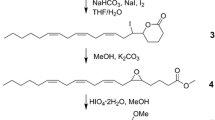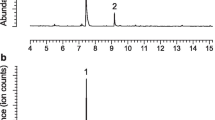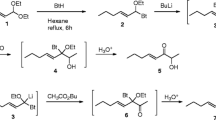Abstract
Bioassays conducted with a Y-tube olfactometer provided evidence that both sexes of the cerambycid beetle Megacyllene caryae (Gahan) were attracted to odor produced by males. Odor collected from male M. caryae contained eight male-specific compounds: a 10:1 blend of (2S,3R)- and (2R,3S)-2,3-hexanediols (representing 3.2 ± 1.3% of the total male-specific compounds), (S)-(−)-limonene (3.1 ± 1.7%), 2-phenylethanol (8.0 ± 2.4%), (−)-α-terpineol (10.0 ± 2.8%), nerol (2.1 ± 1.5%), neral (63.3 ± 7.3%), and geranial (8.8 ± 2.4%). Initial field bioassays determined that none of these compounds was attractive as a single component. Further field trials that used a subtractive bioassay strategy determined that both sexes were attracted to the complete blend of synthetic components, but the elimination of any one component resulted in a decline in trap captures. Blends that were missing (2S,3R)-2,3-hexanediol, (2R,3S)-2,3-hexanediol, or citral (a 1:1 mixture of neral and geranial) attracted no more beetles than did controls. A pheromone blend of this complexity, composed of alkanediols, terpenoids, and aromatic alcohols, is unprecedented for cerambycid species.



Similar content being viewed by others
References
Analytical Software. 2000. Statistix 7.1. Analytical Software, Tallahassee, FL.
Budavari, S. (ed.). 1996. The Merck Index. Merck, Whitehouse Station, NJ.
Dusham, E. H. 1921. The painted hickory borer. Bull. Cornell Univ. Ag. Ext. Stn. 407:170–203.
Hall, D. R., Cork, A., Phythian, S. J., Chittamuru, S., Jayarama, B. K., Venkatesha, M. G., Sheedharan, K., Vinod Kumar, P. K., Seetharama, H. G., and Naidu, R. 2006. Identification of components of male-produced pheromone of coffee white stemborer Xylotrechus quadripes. J. Chem. Ecol. 32:195–219.
Hanks, L. M., Millar, J. G., Moreira, J. A., Barbour, J. D., Lacey, E. S., Mc Elfresh, J. S., Reuter, F. R., and Ray, A. M. 2007. Using generic pheromone lures to expedite identification of aggregation pheromones for the cerambycid beetles Xylotrechus nauticus, Phymatodes lecontii, and Neoclytus modestus modestus. J. Chem. Ecol. 33:889–907.
Iwabuchi, K., Takahashi, J., Nakagawa, Y., and Sakai, T. 1985. Electroantennogram responses of grape borer Xylotrechus pyrrhoderus Bates (Coleoptera: Cerambycidae) to its male sex pheromone components. J. Chem. Ecol. 11:819–828.
Kolb, H. C., Vannieuwenhze, M. S., and Sharpless, K. B. 1994. Catalytic asymmetric dihydroxylation. Chem. Rev. 94:2483–2547.
Lacey, E. S., Ginzel, M. D., Millar, J. G., and Hanks, L. M. 2004. Male-produced aggregation pheromone of the cerambycid beetle Neoclytus acuminatus acuminatus. J. Chem. Ecol. 30:1493–1507.
Lacey, E. S., Ray, A. M., and Hanks, L. M. 2007a. Calling behavior of the cerambycid beetle Neoclytus acuminatus acuminatus. J. Insect Behav. 20:117–128.
Lacey, E. S., Moreira, J. A., Millar, J. G., Ray, A. M., and Hanks, L. M. 2007b. Male-produced aggregation pheromone of the longhorned beetle Neoclytus mucronatus mucronatus. Entomol. Exp. Appl. 122:171–179.
Linsley, E. G. 1964. The Cerambycidae of North America, Part V: Taxonomy and classification of the subfamily Cerambycinae, Tribes Callichromini through Ancylocerini. Univ. Calif. Publ. Entomol. 22:1–197.
Mayer, M. S., and McLaughlin, J. R. (eds.). 1991. Handbook of Insect Pheromones and Sex Attractants. CRC, Boca Raton, FL.
Ray, A. M., Lacey, E. S., and Hanks, L. M. 2006. Predicted taxonomic patterns in pheromone production by longhorned beetles. Naturwissenschaften 93:543–550.
Reddy, G. V. P., Fettköther, R., Noldt, U., and Dettner, K. 2005. Capture of female Hylotrupes bajulus as influenced by trap type and pheromone blend. J. Chem. Ecol. 31:2169–2177.
Schröder, F., Fettköther, R., Noldt, U., Dettner, K., König, W. A., and Francke, W. 1994. Synthesis of (3R)-3-hydroxy-2-hexanone, (2R,3R)-2,3-hexanediol and (2S,3R)-2,3-hexanediol, the male sex pheromone of Hylotrupes bajulus and Pyrrhidium sanguineum (Cerambycidae). Liebigs Annalen der Chemie 1994:1211–1218.
Sokal, R. R., and Rohlf, F. J. 1995. Biometry, 3rd edn. Freeman, New York, NY.
Suckling, D. M., Gibb, A. R., Daly, J. M., Chen, X., and Brockerhoff, E. G. 2001. Behavioral and electrophysiological responses of Arhopalus tristis to burnt pine and other stimuli. J. Chem. Ecol. 27:1091–1104.
Wheeler, J. W., Abraham, M., Highet, R. J., and Duffield, R. M. 1988. Metasternal gland secretion of the locust tree borer, Megacyllene robiniae (Coleoptera: Cerambycidae). Comp. Biochem. Physiol. 91B:771–775.
Yatagai, M., Makihara, H., and Oba, K. 2002. Volatile components of Japanese cedar cultivars as repellents related to resistance to Cryptomeria bark borer. J. Wood Sci. 48:51–55.
Acknowledgments
This project was supported by funds from the Exotic/Invasive Pests and Diseases Research Program, University of California, under USDA-CSREES Grant no. 2004-34439-14691, the Alphawood Foundation, and Hatch Project no. CA-R*ENT-5181H to JGM. This research was in partial fulfillment of a Ph.D. degree for ESL from UIUC.
Author information
Authors and Affiliations
Corresponding author
Rights and permissions
About this article
Cite this article
Lacey, E.S., Moreira, J.A., Millar, J.G. et al. A Male-produced Aggregation Pheromone Blend Consisting of Alkanediols, Terpenoids, and an Aromatic Alcohol from the Cerambycid Beetle Megacyllene caryae . J Chem Ecol 34, 408–417 (2008). https://doi.org/10.1007/s10886-008-9425-3
Received:
Revised:
Accepted:
Published:
Issue Date:
DOI: https://doi.org/10.1007/s10886-008-9425-3




